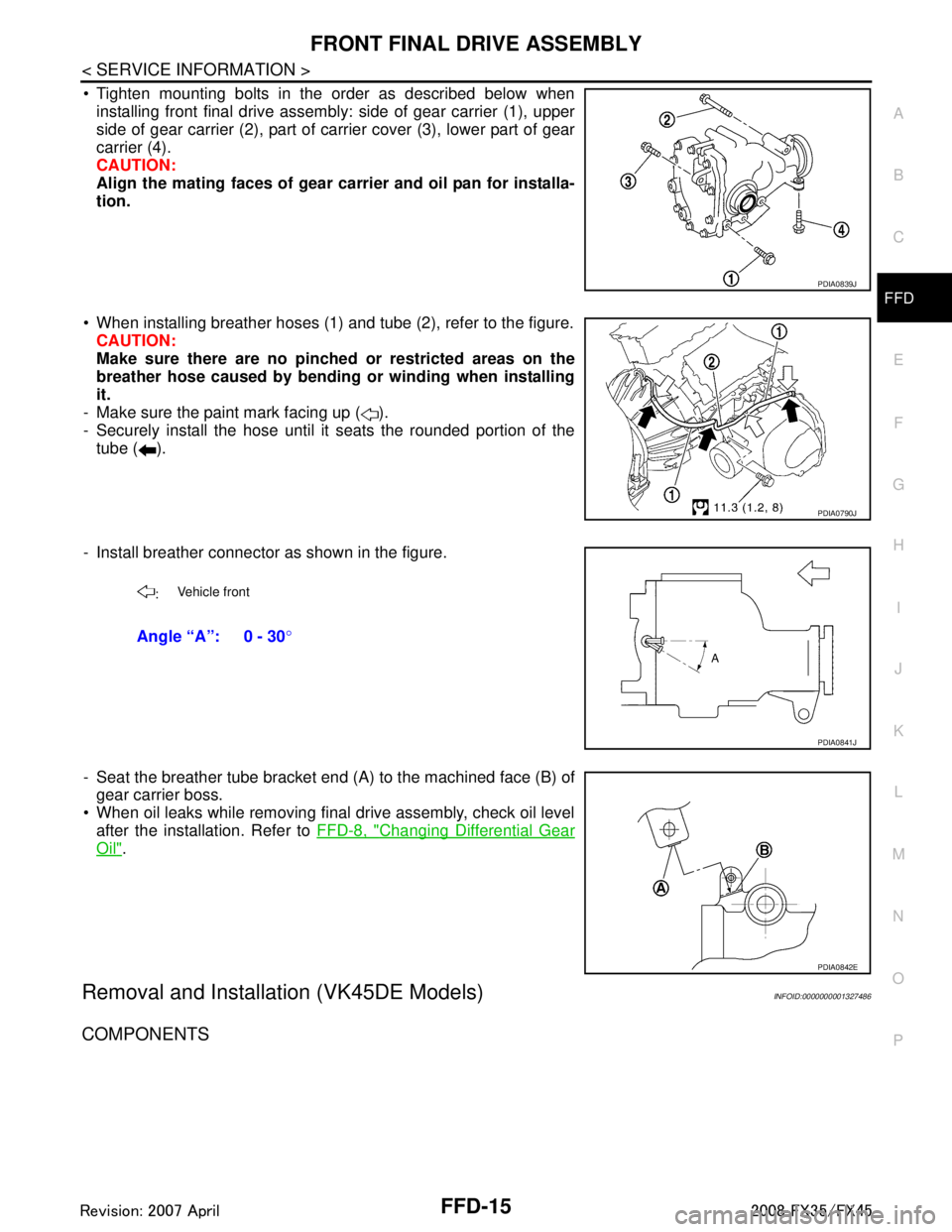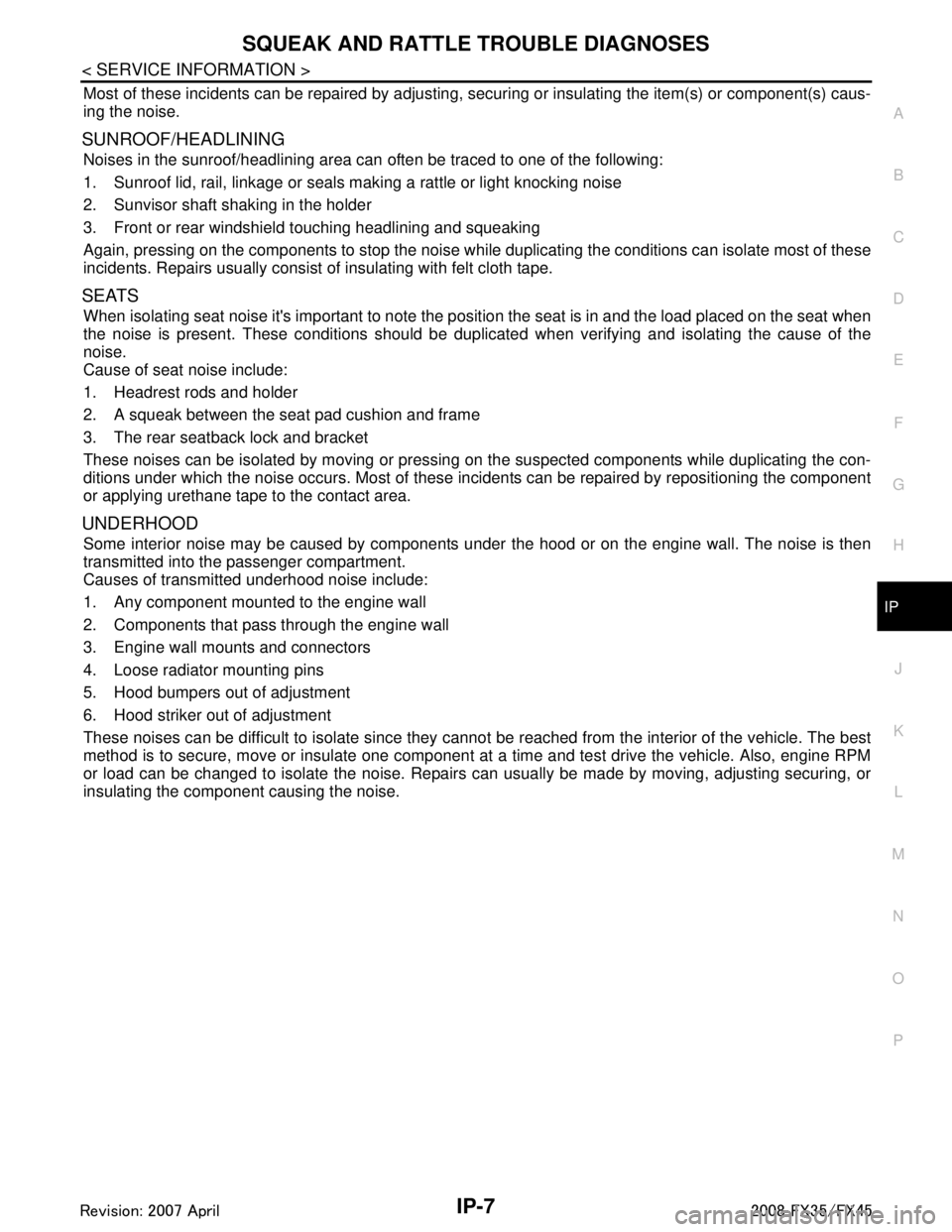2008 INFINITI FX35 seats
[x] Cancel search: seatsPage 2562 of 3924
![INFINITI FX35 2008 Service Manual
EM-78
< SERVICE INFORMATION >[VQ35DE]
TIMING CHAIN
Do not overtighten slack guide
mounting bolts. It is normal
for a gap to exist under the bo lt seats when mounting bolts
are tightened to the speci INFINITI FX35 2008 Service Manual
EM-78
< SERVICE INFORMATION >[VQ35DE]
TIMING CHAIN
Do not overtighten slack guide
mounting bolts. It is normal
for a gap to exist under the bo lt seats when mounting bolts
are tightened to the speci](/manual-img/42/57017/w960_57017-2561.png)
EM-78
< SERVICE INFORMATION >[VQ35DE]
TIMING CHAIN
Do not overtighten slack guide
mounting bolts. It is normal
for a gap to exist under the bo lt seats when mounting bolts
are tightened to the specification.
9. Install the timing chain tensioner (primary) with the following procedure:
a. Pull plunger stopper tab up (or turn lever downward) so as to remove plunger stopper tab from the rachet of plunger.
NOTE:
Plunger stopper tab and lever are synchronized.
b. Push plunger into the inside of tensioner body.
c. Hold plunger in the fully compressed position by engaging plunger stopper tab with the tip of ratchet.
d. To secure lever, insert stopper pin through hole of lever into ten- sioner body hole.
The lever parts and the tab are synchronized. Therefore, theplunger will be secured under this condition.
NOTE:
Figure shows the example of 1.2 mm (0.047 in) diamet er thin screwdriver being used as the stopper pin.
e. Install timing chain tensioner (primary). Remove any dirt and foreign materials completely from theback and the mounting surfaces of timing chain tensioner (pri-
mary).
f. Pull out stopper pin after installing, and then release plunger.
10. Make sure again that the mating marks on sprockets and timing chain have not slipped out of alignment.
11. Install new O-rings on rear timing chain case.
12. Install new front oil seal on front timing chain case. Apply new engine oil to both oil seal lip and dust seal lip.
PBIC2633E
PBIC3568E
PBIC3569E
PBIC2548E
3AA93ABC3ACD3AC03ACA3AC03AC63AC53A913A773A893A873A873A8E3A773A983AC73AC93AC03AC3
3A893A873A873A8F3A773A9D3AAF3A8A3A8C3A863A9D3AAF3A8B3A8C
Page 2594 of 3924
![INFINITI FX35 2008 Service Manual
EM-110
< SERVICE INFORMATION >[VQ35DE]
CYLINDER HEAD
2. Ream cylinder head recess diameter for service valve seat.
Be sure to ream in circles concentric to valve guide center.This will enable valve INFINITI FX35 2008 Service Manual
EM-110
< SERVICE INFORMATION >[VQ35DE]
CYLINDER HEAD
2. Ream cylinder head recess diameter for service valve seat.
Be sure to ream in circles concentric to valve guide center.This will enable valve](/manual-img/42/57017/w960_57017-2593.png)
EM-110
< SERVICE INFORMATION >[VQ35DE]
CYLINDER HEAD
2. Ream cylinder head recess diameter for service valve seat.
Be sure to ream in circles concentric to valve guide center.This will enable valve to fit correctly.
3. Heat cylinder head to 110 to 130 °C (230 to 266 °F) by soaking in
heated oil.
4. Provide valve seats cooled well with dry ice. Force fit valve seat into cylinder head. WARNING:
Cylinder head contains heat. When working, wear protecti ve equipment to avoid getting burned.
CAUTION:
Avoid directly touching cold valve seats.
5. Using the valve seat cutter set (commercial service tool) or valve
seat grinder, finish seat to the specified dimensions. Refer to
EM-149, "
Standard and Limit".
CAUTION:
When using the valve seat cutter, firmly grip cutter handle
with both hands. Then, pr ess on the contacting surface all
around the circumference to cu t in a single drive. Improper
pressure on with cutter or cutting many different times may
result in stage valve seat.
6. Using compound, grind to adjust valve fitting.
7. Check again for normal contact. Refer to "VALVE SEAT CONTACT".
VALVE SPRING SQUARENESS
Set a try square along the side of valve spring and rotate spring. Measure the maximum clearance between the top of spring and try
square.
If it exceeds the limit, replace valve spring.
VALVE SPRING DIMENSIONS AND VALVE SPRING PRESSURE LOAD
Oversize [0.5 mm (0.020 in)] Intake : 38.500 - 38.516 mm (1.5157 - 1.5164 in)
Exhaust : 32.700 - 32.716 mm (1.2874 - 1.2880 in)
SEM795A
SEM008A
SEM934C
Limit : 2.1 mm (0.083 in)
PBIC0080E
3AA93ABC3ACD3AC03ACA3AC03AC63AC53A913A773A893A873A873A8E3A773A983AC73AC93AC03AC3
3A893A873A873A8F3A773A9D3AAF3A8A3A8C3A863A9D3AAF3A8B3A8C
Page 2616 of 3924
![INFINITI FX35 2008 Service Manual
EM-132
< SERVICE INFORMATION >[VQ35DE]
CYLINDER BLOCK
When installing, align connecting rod bearing stopper protru-
sion with cutout of connecting rods and connecting rod bearing
caps to install.
INFINITI FX35 2008 Service Manual
EM-132
< SERVICE INFORMATION >[VQ35DE]
CYLINDER BLOCK
When installing, align connecting rod bearing stopper protru-
sion with cutout of connecting rods and connecting rod bearing
caps to install.](/manual-img/42/57017/w960_57017-2615.png)
EM-132
< SERVICE INFORMATION >[VQ35DE]
CYLINDER BLOCK
When installing, align connecting rod bearing stopper protru-
sion with cutout of connecting rods and connecting rod bearing
caps to install.
Ensure the oil hole on connecting rod and that on the corre- sponding bearing are aligned.
12. Install piston and connecting rod assembly to crankshaft. Position crankshaft pin corresponding to connecting rod to be installed onto the bottom dead center.
Apply engine oil sufficiently to the cylinder bore, piston and crankshaft pin journal.
Match the cylinder position with the cyli nder number on connecting rod to install.
Be sure that front mark on piston crown is facing front of engine.
Using a piston ring compressor (SST) or suitable tool, install
piston with the front mark on t he piston crown facing the front
of the engine.
CAUTION:
Be careful not to damage the cylinder wall and crankshaft
pin, resulting from an interf erence of the connecting rod big
end.
13. Install connecting rod bearing cap. Match the stamped cylinder number marks on connecting rod
with those on connecting rod bearing cap to install.
Be sure that front mark on connecting rod bearing cap is fac- ing front of the engine.
14. Tighten connecting rod bolt as follows:
a. Inspect the outer diameter of connecting rod bolt. Refer to EM-138, "
Inspection After Disassembly".
b. Apply engine oil to the threads and seats of connecting rod bolts.
c. Tighten connecting rod bolts.
PBIC2067E
PBIC2945E
PBIC0809E
: 19.6 N·m (2.0 kg-m, 14 ft-lb)
3AA93ABC3ACD3AC03ACA3AC03AC63AC53A913A773A893A873A873A8E3A773A983AC73AC93AC03AC3
3A893A873A873A8F3A773A9D3AAF3A8A3A8C3A863A9D3AAF3A8B3A8C
Page 2719 of 3924
![INFINITI FX35 2008 Service Manual
CYLINDER HEADEM-235
< SERVICE INFORMATION > [VK45DE]
C
D
E
F
G H
I
J
K L
M A
EM
NP
O
VALVE SEAT REPLACEMENT
When valve seat is removed, replace with
oversized [0.5 mm (0.020 in)] valve seat.
1. Bore INFINITI FX35 2008 Service Manual
CYLINDER HEADEM-235
< SERVICE INFORMATION > [VK45DE]
C
D
E
F
G H
I
J
K L
M A
EM
NP
O
VALVE SEAT REPLACEMENT
When valve seat is removed, replace with
oversized [0.5 mm (0.020 in)] valve seat.
1. Bore](/manual-img/42/57017/w960_57017-2718.png)
CYLINDER HEADEM-235
< SERVICE INFORMATION > [VK45DE]
C
D
E
F
G H
I
J
K L
M A
EM
NP
O
VALVE SEAT REPLACEMENT
When valve seat is removed, replace with
oversized [0.5 mm (0.020 in)] valve seat.
1. Bore out old seat until it collapses. Boring shoul d not continue beyond the bottom face of the seat recess
in cylinder head. Set the machine depth stop to ensure this. Refer to EM-266, "
Standard and Limit".
CAUTION:
Prevent to scratch cylinder head by excessive boring.
2. Ream cylinder head recess diameter for service valve seat.
Be sure to ream in circles concentric to valve guide center.This will enable valve to fit correctly.
3. Heat cylinder head to 110 to 130 °C (230 to 266 °F) by soaking in
heated oil.
4. Provide valve seats cooled well with dry ice. Force fit valve seat into cylinder head. CAUTION:
Avoid directly touching cold valve seats.
Cylinder head contains heat. Wh en working, wear protective equipment to avoid getting burned.
5. Using valve seat cutter set (commercial service tool) or valve seat grinder, finish seat to the specified dimensions. Refer to
EM-266, "
Standard and Limit".
CAUTION:
When using valve seat cutter, firmly grip cutter handle with
both hands. Then, press on the contacting surface all
around the circumference to cu t in a single drive. Improper
pressure on with cutter or cu tting many different times may
result in stage valve seat.
6. Using compound, grind to adjust valve fitting.
7. Check again for normal contact. Refer to "VALVE SEAT CONTACT".
VALVE SPRING SQUARENESS
Oversize (Service) [0.5 mm (0.020 in)] Intake : 37.500 - 37.516 mm (1.4764 - 1.4770 in)
Exhaust : 32.700 - 32.716 mm (1.2874 - 1.2880 in)
SEM795A
SEM008A
SEM934C
3AA93ABC3ACD3AC03ACA3AC03AC63AC53A913A773A893A873A873A8E3A773A983AC73AC93AC03AC3
3A893A873A873A8F3A773A9D3AAF3A8A3A8C3A863A9D3AAF3A8B3A8C
Page 2733 of 3924
![INFINITI FX35 2008 Service Manual
CYLINDER BLOCKEM-249
< SERVICE INFORMATION > [VK45DE]
C
D
E
F
G H
I
J
K L
M A
EM
NP
O
Position each ring with the gap as shown in the figure, refer-
ring to the piston front mark.
Install top rin INFINITI FX35 2008 Service Manual
CYLINDER BLOCKEM-249
< SERVICE INFORMATION > [VK45DE]
C
D
E
F
G H
I
J
K L
M A
EM
NP
O
Position each ring with the gap as shown in the figure, refer-
ring to the piston front mark.
Install top rin](/manual-img/42/57017/w960_57017-2732.png)
CYLINDER BLOCKEM-249
< SERVICE INFORMATION > [VK45DE]
C
D
E
F
G H
I
J
K L
M A
EM
NP
O
Position each ring with the gap as shown in the figure, refer-
ring to the piston front mark.
Install top ring and second ring with the stamped surface fac-
ing upward.
12. Install connecting rod bearings to connecting rod and connecting rod bearing cap. Before installing connecting rod bearings, apply engine oi l to the bearing surface (inside). Do not apply
engine oil to the back surface, but thoroughly clean it.
When installing, align the connecting rod bearing stopper pro-
trusion with the cutout of connecting rod and connecting rod
bearing cap to install.
Ensure the oil holes on connecting rod and that on the corre-
sponding bearing are aligned.
13. Install piston and connecting rod assembly to crankshaft. Position the crankshaft pin corresponding to connecting rod to be installed onto the bottom dead center.
Apply engine oil sufficiently to the cylinder bore, piston and crankshaft pin journal.
Match the cylinder position with the cylinder No. on connecting rod to install.
Be sure that front mark on piston head is facing front of engine.
Using piston ring compressor [SST: EM03470000 (J8037)], install piston with the front ma rk on the piston head facing the
front of engine.
CAUTION:
Be careful not to damage cylinder wall and crankshaft pin,
resulting from an interferen ce of the connecting rod big
end.
14. Install connecting rod bearing cap. Match the stamped cylinder number marks on connecting rodwith those on cap to install.
15. Tighten connecting rod nuts as follows:
a. Apply new engine oil to the threads and seats of connecting rod bolts and nuts.
b. Tighten connecting rod nuts. Stamped mark
To p r i n g : R
Second ring : 2R
PBIC0100E
PBIC2370E
PBIC0102E
PBIC2164E
3AA93ABC3ACD3AC03ACA3AC03AC63AC53A913A773A893A873A873A8E3A773A983AC73AC93AC03AC3
3A893A873A873A8F3A773A9D3AAF3A8A3A8C3A863A9D3AAF3A8B3A8C
Page 2806 of 3924

FRONT FINAL DRIVE ASSEMBLYFFD-15
< SERVICE INFORMATION >
CEF
G H
I
J
K L
M A
B
FFD
N
O P
Tighten mounting bolts in the order as described below when installing front final drive assembly: side of gear carrier (1), upper
side of gear carrier (2), part of ca rrier cover (3), lower part of gear
carrier (4).
CAUTION:
Align the mating faces of gear car rier and oil pan for installa-
tion.
When installing breather hoses (1) and tube (2), refer to the figure. CAUTION:
Make sure there are no pinched or restricted areas on the
breather hose caused by bending or winding when installing
it.
- Make sure the paint mark facing up ( ).
- Securely install the hose until it seats the rounded portion of the
tube ( ).
- Install breather connector as shown in the figure.
- Seat the breather tube bracket end (A) to the machined face (B) of gear carrier boss.
When oil leaks while removing final drive assembly, check oil level after the installation. Refer to FFD-8, "
Changing Differential Gear
Oil".
Removal and Installation (VK45DE Models)INFOID:0000000001327486
COMPONENTS
PDIA0839J
PDIA0790J
:Vehicle front
Angle “A”: 0 - 30
°
PDIA0841J
PDIA0842E
3AA93ABC3ACD3AC03ACA3AC03AC63AC53A913A773A893A873A873A8E3A773A983AC73AC93AC03AC3
3A893A873A873A8F3A773A9D3AAF3A8A3A8C3A863A9D3AAF3A8B3A8C
Page 2921 of 3924

GW-8
< SERVICE INFORMATION >
SQUEAK AND RATTLE TROUBLE DIAGNOSES
Most of these incidents can be repaired by adjusting, securing or insulatingthe item(s) or component(s) caus-
ing the noise.
SUNROOF/HEADLINING
Noises in the sunroof/headlining area c an often be traced to one of the following:
1. Sunroof lid, rail, linkage or seals making a rattle or light knockingnoise
2. Sunvisor shaft shaking in the holder
3. Front or rear windshield touching headlining and squeaking
Again, pressing on the components to stop the noise while duplicatingthe conditions can isolate most of these
incidents. Repairs usually consistof insulating with felt cloth tape.
SEATS
When isolating seat noise it's important to note the pos ition the seatis in and the load placed on the seat when
the noise is present. These conditionsshould be duplic ated when verifying and isolating the cause of the
noise.
Cause of seat noise include:
1. Headrest rods and holder
2. A squeak between the seat pad cushion and frame
3. The rear seatback lock and bracket
These noises can be isolated by moving or pressing on the suspectedcomponents while duplicating the condi-
tions under which the noise occurs.Most of these incidents can be repaired by repositioning the component
orapplying urethane tape to the contact area.
UNDERHOOD
Some interior noise may be caused by components under the hood or onthe engine wall. The noise is then
transmitted into the passenger compartment.
Causes of transmitted underhood noise include:
1. Any component mounted to the engine wall
2. Components that pass through the engine wall
3. Engine wall mounts and connectors
4. Loose radiator mounting pins
5. Hood bumpers out of adjustment
6. Hood striker out of adjustment
These noises can be difficult to isolate since they cannot be reached from the interior of the vehicle. The best
method is to secure, move or insulate one component at a time and test drive the \
vehicle. Also, engine RPM
or load can be changed to isolate the noise. Repairs can usually be made by moving, adjusting, securing, or
insulating the component causing the noise.
3AA93ABC3ACD3AC03ACA3AC03AC63AC53A913A773A893A873A873A8E3A773A983AC73AC93AC03AC3
3A893A873A873A8F3A773A9D3AAF3A8A3A8C3A863A9D3AAF3A8B3A8C
Page 3008 of 3924

SQUEAK AND RATTLE TROUBLE DIAGNOSESIP-7
< SERVICE INFORMATION >
C
DE
F
G H
J
K L
M A
B
IP
N
O P
Most of these incidents can be repaired by adjusting, se curing or insulating the item(s) or component(s) caus-
ing the noise.
SUNROOF/HEADLINING
Noises in the sunroof/headlining area can often be traced to one of the following:
1. Sunroof lid, rail, linkage or seals making a rattle or light knocking noise
2. Sunvisor shaft shaking in the holder
3. Front or rear windshield touching headlining and squeaking
Again, pressing on the components to stop the noise while duplicating the conditions can isolate most of these
incidents. Repairs usually consist of insulating with felt cloth tape.
SEATS
When isolating seat noise it's important to note the pos ition the seat is in and the load placed on the seat when
the noise is present. These conditions should be duplic ated when verifying and isolating the cause of the
noise.
Cause of seat noise include:
1. Headrest rods and holder
2. A squeak between the seat pad cushion and frame
3. The rear seatback lock and bracket
These noises can be isolated by moving or pressing on the suspected components while duplicating the con-
ditions under which the noise occurs. Most of thes e incidents can be repaired by repositioning the component
or applying urethane tape to the contact area.
UNDERHOOD
Some interior noise may be caused by components under the hood or on the engine wall. The noise is then
transmitted into the passenger compartment.
Causes of transmitted underhood noise include:
1. Any component mounted to the engine wall
2. Components that pass through the engine wall
3. Engine wall mounts and connectors
4. Loose radiator mounting pins
5. Hood bumpers out of adjustment
6. Hood striker out of adjustment
These noises can be difficult to isolate since they cannot be reached from the interior of the vehicle. The best
method is to secure, move or insulate one component at a time and test drive the vehicle. Also, engine RPM
or load can be changed to isolate the noise. Repairs c an usually be made by moving, adjusting securing, or
insulating the component causing the noise.
3AA93ABC3ACD3AC03ACA3AC03AC63AC53A913A773A893A873A873A8E3A773A983AC73AC93AC03AC3
3A893A873A873A8F3A773A9D3AAF3A8A3A8C3A863A9D3AAF3A8B3A8C